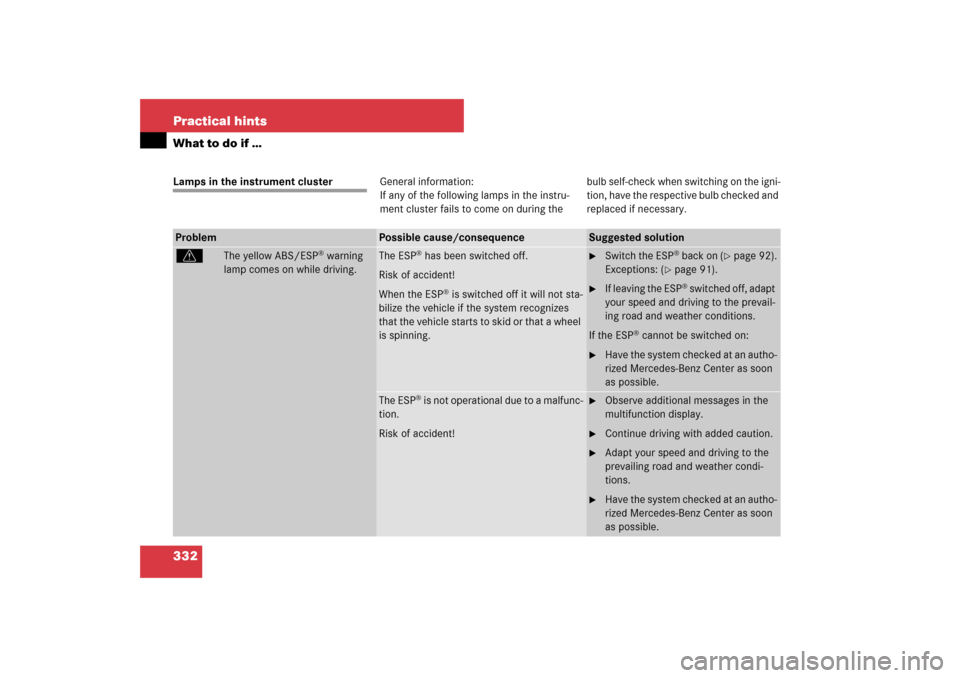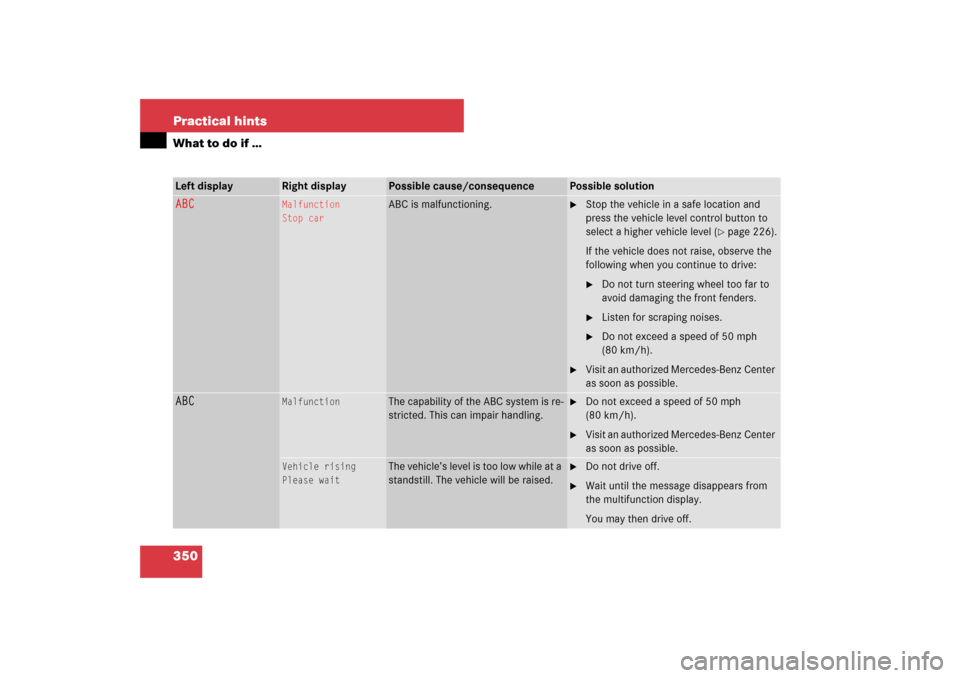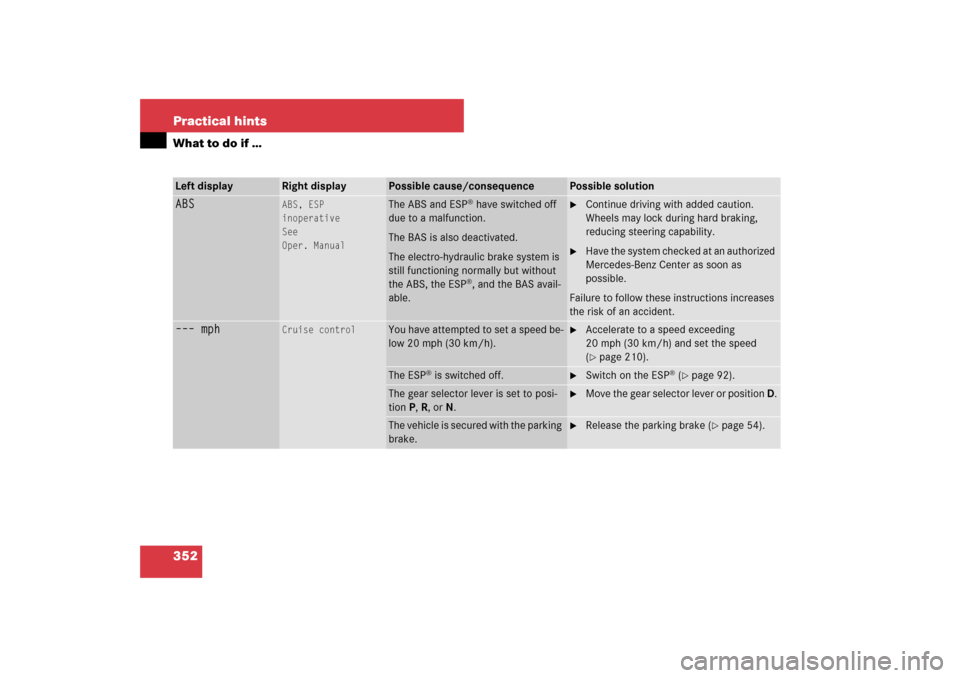Page 333 of 473

332 Practical hintsWhat to do if …Lamps in the instrument clusterGeneral information:
If any of the following lamps in the instru-
ment cluster fails to come on during thebulb self-check when switching on the igni-
tion, have the respective bulb checked and
replaced if necessary.Problem
Possible cause/consequence
Suggested solution
v
The yellow ABS/ESP
® warning
lamp comes on while driving.
The ESP
® has been switched off.
Risk of accident!
When the ESP
® is switched off it will not sta-
bilize the vehicle if the system recognizes
that the vehicle starts to skid or that a wheel
is spinning.
�
Switch the ESP
® back on (
�page 92).
Exceptions: (
�page 91).
�
If leaving the ESP
® switched off, adapt
your speed and driving to the prevail-
ing road and weather conditions.
If the ESP
® cannot be switched on:
�
Have the system checked at an autho-
rized Mercedes-Benz Center as soon
as possible.
The ESP
® is not operational due to a malfunc-
tion.
Risk of accident!
�
Observe additional messages in the
multifunction display.
�
Continue driving with added caution.
�
Adapt your speed and driving to the
prevailing road and weather condi-
tions.
�
Have the system checked at an autho-
rized Mercedes-Benz Center as soon
as possible.
Page 335 of 473

334 Practical hintsWhat to do if …Problem
Possible cause/consequence
Suggested solution
-
The yellow ABS indicator lamp
comes on while driving.
The ABS has detected a malfunction and has
switched off. The BAS and the ESP
® are also
switched off (see messages in display).
The electro-hydraulic brake system is still
functioning normally but without ABS avail-
able.
If the ABS control unit is malfunctioning, oth-
er systems such as Parktronic*, Distronic*,
or the automatic transmission may also be
malfunctioning.
�
Continue driving with added caution.
Wheels may lock during hard braking,
reducing steering capability.
�
Have the system checked at an autho-
rized Mercedes-Benz Center as soon
as possible.
Failure to follow these instructions in-
creases the risk of an accident.
�
Read and observe messages in the
display (
�page 347).
The charging voltage has fallen below
10 volts and the ABS was switched off.
The battery may not be sufficiently charged.
�
Switch off electrical consumers that
are currently not needed, e.g. seat
heating.
�
If necessary, have the generator and
battery checked.
When the voltage is above this value
again, the ABS is operational again.
Page 345 of 473

344 Practical hintsWhat to do if …Warning!
G
Each tire, including the spare (if provided),
should be checked monthly when cold and
inflated to the inflation pressure recom-
mended by the vehicle manufacturer on the
vehicle placard or the tire inflation pressure
label. If your vehicle has tires of a different
size than the size indicated on the vehicle
placard or the tire inflation pressure label,
you should determine the proper tire infla-
tion pressure for those tires.
As an added safety feature, your vehicle has
been equipped with a tire pressure monitor-
ing system (TPMS) that illuminates a low tire
pressure telltale when one or more of your
tires is significantly under-inflated. Accord-
ingly, when the low tire pressure telltale illu-
minates, you should stop and check your
tires as soon as possible, and inflate them to
the proper pressure. Driving on a significant-
ly underinflated tire causes the tire to over-
heat and can lead to tire failure.
Underinflation also reduces fuel efficiency
and tire tread life, and may affect the vehi-
cle’s handling and stopping ability. Please
note that the TPMS is not a substitute for
proper tire maintenance, and it is the driv-
er’s responsibility to maintain correct tire
pressure, even if underinflation has not
reached the level to trigger illumination of
the TPMS low tire pressure telltale.
USA only:
Your vehicle has also been equipped with a
TPMS malfunction indicator to indicate
when the system is not operating properly.
The TPMS malfunction indicator is com-
bined with the low tire pressure telltale.
When the system detects a malfunction, the
telltale will flash for approximately
one minute and then remain continuously
illuminated. This sequence will continue
upon subsequent vehicle start-ups as long
as the malfunction exists. When the mal-
function indicator is illuminated, the system
may not be able to detect or signal low tire
pressure as intended.
TPMS malfunctions may occur for a variety
of reasons, including the installation of in-
compatible replacement or alternate tires or
wheels on the vehicle that prevent the TPMS
from functioning properly. Always check the
TPMS malfunction telltale after replacing
one or more tires or wheels on your vehicle
to ensure that the replacement or alternate
tires and wheels allow the TPMS to continue
to function properly.
Page 348 of 473

347 Practical hints
What to do if …
Vehicle status messages in the multi-function display
Warning and malfunction messages ap-
pear in the in the multifunction display lo-
cated in the instrument cluster.
Certain warning and malfunction messag-
es are accompanied by an audible signal.
Address these messages accordingly and
follow the additional instructions given in
this Operator’s Manual.
Selecting the vehicle status message
memory menu in the control system
(�page 152) displays both cleared and
uncleared messages.
High-priority messages appear in the mul-
tifunction display in red color.Certain messages of high priority cannot
be cleared from the multifunction display
using the reset button (
�page 26) or but-
ton j, k, ÿ, or è on the
multifunction steering wheel.
Other messages of high priority and mes-
sages of less immediate priority can be
cleared from the multifunction display us-
ing the reset button or button j, k,
ÿ, or è on the multifunction steer-
ing wheel. They are then stored in the vehi-
cle status message memory (
�page 152).
Remember that clearing a message will not
correct the condition that caused the mes-
sage to appear.
Warning!
G
All categories of messages contain impor-
tant information which should be taken note
of and, where a malfunction is indicated, ad-
dressed as soon as possible at an autho-
rized Mercedes-Benz Center.
Failure to repair condition noted may cause
damage not covered by the Mercedes-Benz
Limited Warranty, or result in property dam-
age or personal injury.
Page 351 of 473

350 Practical hintsWhat to do if …Left display
Right display
Possible cause/consequence
Possible solution
ABC
Malfunction
Stop car
ABC is malfunctioning.
�
Stop the vehicle in a safe location and
press the vehicle level control button to
select a higher vehicle level (
�page 226).
If the vehicle does not raise, observe the
following when you continue to drive:
�
Do not turn steering wheel too far to
avoid damaging the front fenders.
�
Listen for scraping noises.
�
Do not exceed a speed of 50 mph
(80 km/h).
�
Visit an authorized Mercedes-Benz Center
as soon as possible.
ABC
Malfunction
The capability of the ABC system is re-
stricted. This can impair handling.
�
Do not exceed a speed of 50 mph
(80 km/h).
�
Visit an authorized Mercedes-Benz Center
as soon as possible.
Vehicle rising
Please wait
The vehicle’s level is too low while at a
standstill. The vehicle will be raised.
�
Do not drive off.
�
Wait until the message disappears from
the multifunction display.
You may then drive off.
Page 352 of 473
351 Practical hints
What to do if …
Left display
Right display
Possible cause/consequence
Possible solution
ABS
ABS, ESP
unavailable
See
Oper. Manual
The ABS and ESP
® are not available
due to a malfunction. The BAS is also
deactivated.
The system’s self-diagnosis may not
be completed yet.
The electro-hydraulic brake system is
still functioning normally but without
the ABS, the ESP®, and the BAS avail-
able.
�
Drive a short distance with added caution
at a vehicle speed of above 12 mph
(20 km/h).
When the message disappears, the ABS,
the ESP
®, and the BAS are available again.
If the message does not disappear:
�
Continue driving with added caution.
Wheels may lock during hard braking,
reducing steering capability.
�
Have the system checked at an authorized
Mercedes-Benz Center as soon as
possible.
Failure to follow these instructions increases
the risk of an accident.
Page 353 of 473

352 Practical hintsWhat to do if …Left display
Right display
Possible cause/consequence
Possible solution
ABS
ABS, ESP
inoperative
See
Oper. Manual
The ABS and ESP
® have switched off
due to a malfunction.
The BAS is also deactivated.
The electro-hydraulic brake system is
still functioning normally but without
the ABS, the ESP®, and the BAS avail-
able.
�
Continue driving with added caution.
Wheels may lock during hard braking,
reducing steering capability.
�
Have the system checked at an authorized
Mercedes-Benz Center as soon as
possible.
Failure to follow these instructions increases
the risk of an accident.
––– mph
Cruise control
You have attempted to set a speed be-
low 20 mph (30 km/h).
�
Accelerate to a speed exceeding
20 mph (30 km/h) and set the speed
(�page 210).
The ESP
® is switched off.
�
Switch on the ESP
® (�page 92).
The gear selector lever is set to posi-
tion P, R, or N.
�
Move the gear selector lever or position D.
The vehicle is secured with the parking
brake.
�
Release the parking brake (
�page 54).
Page 356 of 473

355 Practical hints
What to do if …
Left display
Right display
Possible cause/consequence
Possible solution
ESP
ESP
inoperative
See
Oper. Manual
The ESP
® has detected a malfunction
and switched off.
The ABS may not be operational.
The electro-hydraulic brake system is
still functioning normally but without
the ESP® available.
�
Continue driving with added caution.
�
Have the system checked at an authorized
Mercedes-Benz Center as soon as
possible.
Failure to follow these instructions increases
the risk of an accident.
ESP unavailable
See
Oper. Manual
The ESP
® is deactivated because the
power supply has been interrupted.
The electro-hydraulic brake system is
still functioning normally but without
the ESP® available.
�
Synchronize the ESP
®. With the vehicle
stationary, turn the steering wheel com-
pletely to the left and then to the right.
If the ESP
® message does not go out:
�
Continue driving with added caution.
�
Have the system checked at an authorized
Mercedes-Benz Center as soon as
possible.
Failure to follow these instructions increases
the risk of an accident.
!
When sychronizing the ESP
®, make sure you
can turn the steering wheel in both directions as
far as it will go without the wheels hitting any ob-
jects, e.g. a road curb.